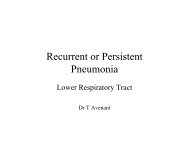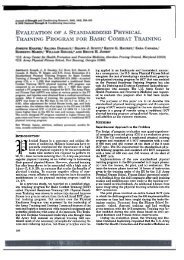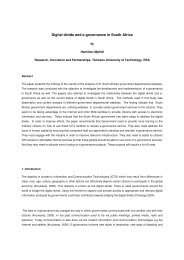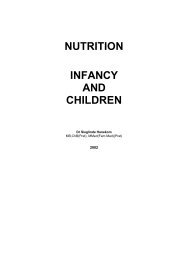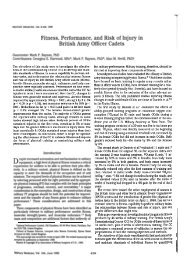Research and Training Strategies for Goat Production Systems in ...
Research and Training Strategies for Goat Production Systems in ...
Research and Training Strategies for Goat Production Systems in ...
You also want an ePaper? Increase the reach of your titles
YUMPU automatically turns print PDFs into web optimized ePapers that Google loves.
Potential of goats <strong>in</strong> the arid sweet bushveld of the Northern Prov<strong>in</strong>ce<br />
Izak du Plessis<br />
Mara Agricultural Development Centre<br />
Introduction<br />
Small stock at present plays a small but important role <strong>in</strong> agriculture <strong>in</strong> the Northern Prov<strong>in</strong>ce.<br />
Apart from few farmers with large flocks of goats (ma<strong>in</strong>ly Boer goats) most other farmers also<br />
keep small flocks of goats (∀ 15 - 20 goats). Communal farmers keep these small flocks <strong>for</strong><br />
rations <strong>for</strong> their labourers <strong>for</strong> a number of other reasons (religion, rituals, own consumption, etc).<br />
Reproduction<br />
A trial with Boer goats <strong>and</strong> <strong>in</strong>digenous goats were conducted at Mara ADC from 1988 to 1991.<br />
The two flocks were managed as to simulate the management that they are traditionally subjected<br />
to. The Boer goats were manage <strong>in</strong>tensively, hav<strong>in</strong>g a breed<strong>in</strong>g season (1 July to 15 August),<br />
treated when ill <strong>and</strong> had dos<strong>in</strong>g, dipp<strong>in</strong>g <strong>and</strong> <strong>in</strong>oculation programmes. The Indigenous goats were<br />
mated throughout the year. Orig<strong>in</strong>ally, they received no treatments but later on they were treated<br />
to lower the mortality rate <strong>and</strong> rather <strong>in</strong>crease the output (production <strong>and</strong> economic outputs) of the<br />
flock. Animals that were treated, were culled as well as the kids if the ewe was treated be<strong>for</strong>e the<br />
kids were weaned. They also did not have dos<strong>in</strong>g, dipp<strong>in</strong>g <strong>and</strong> <strong>in</strong>oculation programmes. The<br />
follow<strong>in</strong>g are some of the results from this trial.<br />
The data <strong>for</strong> the different years were pooled (Table 1) <strong>and</strong> suggests that the Boer goats have more<br />
multiple births (11.2%) than the Indigenous goats.<br />
Table 1 The frequency of s<strong>in</strong>gle <strong>and</strong> multiple births <strong>in</strong> Boer- <strong>and</strong> Indigenous goats<br />
Breed % S<strong>in</strong>gle % Multiple<br />
Boer goat 34.4 65.6<br />
Indigenous goat 45.6 54.4<br />
From Tables 2 <strong>and</strong> 3 it can be deducted that both breeds have a high fecundity rate <strong>and</strong> that the<br />
Boer goats have a moderate conception rate. With a kidd<strong>in</strong>g <strong>in</strong>terval of less than 240 days the<br />
Indigenous goats were able to compensate <strong>for</strong> the lower number of multiple births that occurred.<br />
Table 2 Reproduction per<strong>for</strong>mance of the Boer goats<br />
Year n Mated n Kidded n Born n Weaned n Kidded/<br />
n Mated<br />
n Born/<br />
n Kidded<br />
1988 35 21 27 25 0.60 1.29<br />
1989 36 24 37 32 0.67 1.54<br />
1990 30 12 17 13 0.40 1.42<br />
1991 26 21 39 24 0.84 1.86<br />
Total 126 78 120 94 0.62 1.54<br />
Table 3 Reproduction per<strong>for</strong>mance of the Indigenous goats<br />
46








